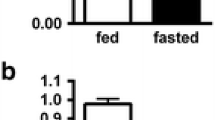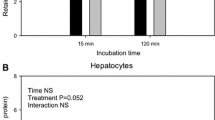Abstract
To examine the ability of pike (Esox lucius L.) to modify exogenous PUFA by desaturation and elongation, 14C-labelled 18:2(n-6), 18:3(n-3), 20:4(n-6) and 20:5(n-3) were injected intraperitoneally and the distribution of radioactivity in tissue lipid classes and liver PUFA measured. In all tissues examined, radioactivity from all 14C-PUFA was recovered in many classes of acyl lipids and the level of recovery generally reflected the relative abundance of the lipid classes. Triacylglycerols, CGP and EGP usually contained high levels of all incorporated 14C-PUFA. PI contained higher levels of radioactivity from 14C-20:4(n-6) than from other injected substrates. In liver lipid, the Δ6 desaturation products of 14C-18:2(n-6) and 14C-18:3(n-3) contained no measurable radioactivity although the elongation products of the Δ6 desaturation products were labelled, as were the direct elongation products of these injected substrates. No radioactivity from 14C-18:2(n-6) or 14C-18:3(n-3) was detected in C20 or C22 products of Δ5 and Δ4 desaturation. Almost all radioactivity from injected 14C-20:4(n-6) was recovered in this PUFA. Of the total radioactivity from 14C-20:5(n-3) incorporated into liver lipid, 7% was present as 24:5 and 16.4% was recovered in hexaenoic fatty acids. In liver, 24:5(n-3) and 24:6(n-3) each accounted for 1% of the mass of total fatty acids and were located almost exclusively in triacylglycerols. The presence of radioactivity in these C24 PUFA suggests that in pike the synthesis of 22:6(n-3) from 20:5(n-3) may proceed without Δ4 desaturase via the pathway which involves chain shortening of 24:6(n-3). It is concluded that under the circumstances employed in this study pike, do not exhibit Δ5 desaturase activity and are unable to synthesize 20:4(n-6) and 20:5(n-3) from 18:2(n-6) and 18:3(n-3), respectively. This suggests that pike may require 20:4(n-6) and 20:5(n-3) preformed in the diet.
Similar content being viewed by others
Abbreviations
- CGP:
-
choline glycerophospholipids
- CL:
-
cardiolipin
- EGP:
-
ethanolamine glycerophospholipids
- PG:
-
phosphatidylglycerol
- PI:
-
phosphatidylinositol
- PS:
-
phosphatidylserine
- PUFA:
-
polyunsaturated fatty acids
- SM:
-
sphingomyelin
- TLC:
-
thin-layer chromatography
References cited
Aveldano, M.I., Robinson, B.S., Johnson, D.W. and Poulos, A. 1993. Long and very long chain polyunsaturated fatty acids of the n-6 series in rat seminiferous tubules. J. Biol. Chem. 268: 11663–11669.
Christie, W.W. 1982. Lipid Analysis, 2nd. Edn. Pergamon Press, Oxford.
Christie, W.W., Brechany, E.Y., Johnson, S.B. and Holman, R.T. 1986. A comparison of pyrrolidide and picolinyl ester derivatives for the identification of fatty acids in natural samples by gas chromatography-mass spectrometry. Lipids 21: 657–661.
Desvilettes, C., Bourdier, G. and Breton, J.-C. 1994. Lipid class and fatty acid composition of planktivorous larval pike Esox lucius living in a natural pond. Aquat. Living Res. 7: 67–77.
Glass, R.L., Krick, T.P. and Eckhardt, A.E. 1974. New series of fatty acids in northern pike (Esox lucius). Lipids 9: 1004–1008.
Glass, R.L., Krick, T.P., Sand, D.M., Rahn, C.H. and Schlenk, H. 1975. Furanoid fatty acids in fish lipids. Lipids 10: 695–702.
Gunstone, F.D., Wijesundera, R.C. and Scrimgeour, C.M. 1978. The component acids of lipids from marine and freshwater species with special reference to furan-containing acids. J. Sci. Food Agric. 29: 539–550.
Hanson, B.J., Cummins, K.W., Cargill, A.S. and Lowry, R.R. 1985. Lipid content, fatty acid composition and the effect of diet on fats of aquatic insects. Comp. Biochem. Physiol. 80B: 257–276.
Hassam, A.G., Rivers, J.P.W. and Crawford, M.A. 1977. The failure of the cat to desaturate linoleic acid: its nutritional implications. Nutr. Metab. 21: 321–328.
Henderson, R.J. and Tocher, D.R. 1987. The lipid composition and biochemistry of freshwater fish. Prog. Lipid Res. 26: 281–347.
Linares, F. and Henderson, R.J. 1991. Incorporation of 14C-labelled polyunsaturated fatty acids by juvenile turbot, Scophthalmus maximus (L.) in vivo. J. Fish Biol. 38: 335–347.
Linko, R.R. and Karinkata, H. 1970. Fatty acids of long chain length in Baltic herring lipids. J. Amer. Oil Chem. Soc. 47: 42–46.
Mourente, G. and Tocher, D.R. 1993a. Incorporation and metabolism of 14C-labelled polyunsaturated fatty acids in juvenile gilthead sea bream Sparus aurata L. in vivo. Fish Physiol. Biochem. 11: 443–453.
Mourente, G. and Tocher, D.R. 1993b. Incorporation and metabolism of 14C-labelled polyunsaturated fatty acids in wild-caught juveniles of golden grey mullet, Liza aurata, in vivo. Fish Physiol. Biochem. 12: 119–130.
Olsen, R.E. and Henderson, R.J. 1989. The rapid analysis of neutral and polar marine lipids using double-development HPTLC and scanning densitometry. J. Exp. Mar. Biol. Ecol. 129: 189–197.
Olsen, R.E., Henderson, R.J. McAndrew, B.J. 1990. The conversion of linoleic acid and linolenic acid to longer chain polyunsaturated fatty acids by Tilapia (Oreochromis) nilotica in vivo. Fish Physiol. Biochem. 8: 261–270.
Ota, T., Kawabata, Y. and Ando, Y. 1994. Positional distribution of 24:6(n-3) in triacyl-sn-glycerols from flathead flounder liver and flesh. J. Amer. Oil Chem. Soc. 71: 475–478.
Owen, J.M., Adron, J.W., Middleton, C. and Cowey, C.B. 1975. Elongation and desaturation of dietary fatty acids in turbot Scophthalmus maximus and rainbow trout Salmo gairdneri. Lipids 10: 528–531.
Rivers, J.P.W., Sinclair, A.J. and Crawford, M.A. 1975. Inability of the cat to desaturate essential fatty acids. Nature, Lond. 258: 1171–1173.
Sargent, J.R., Bell, J.G., Bell, M.V., Henderson, R.J. and Tocher, D.W. 1993. The metabolism of phospholipids and polyunsaturated fatty acids in fish. In Aquaculture: Fundamental and Applied Research. pp. 103–124. Edited by B. Lahlou and P. Vitiello. Coastal and Estuarine Studies 43. American Geophysical Union, Washington, DC.
Sastry, P.S. 1985. Lipids of nervous tissue: composition and metabolism. Progr. Lipid Res. 24: 69–176.
Schwalme, K. 1992. A quantitative comparison between diet and body fatty acid composition in wild northern pike (Esox lucius L.). Fish Physiol. Biochem. 10: 91–98.
Schwalme, K. and Mackay, W.C. 1992. Seasonal changes in the neutral and polar fatty acid content of female northern pike (Esox lucius L.). Can. J. Zool. 70: 280–287.
Schwalme, K., Mackay, W.C. and Clandinin, M.T. 1993. Seasonal dynamics of fatty acid composition in female northern pike (Esox lucius L.). J. Comp. Physiol. B. 163: 277–287.
Sinclair, A.J., Slattery, W., McLean, J.G. and Monger, E.A. 1981. Essential fatty acid deficiency and evidence for arachidonate synthesis in the cat. Br. J. Nutr. 46: 93–96.
Sinclair, A.J., McLean, J.G. and Monger, E.A. 1979. Metabolism of linoleic acid in the cat. Lipids 14: 932–936.
Treasurer, J. and Owen, R. 1991. Food and growth of pike, Esox lucius, in simple fish communities in lakes of different trophic status. Aquat. Living Resourc. 4: 289–292.
Tocher, D.R. and Harvie, D.G. 1988. Fatty acid composition of the major phosphoglycerides from fish neural tissues; (n-3) and (n-6) polyunsaturated fatty acids in rainbow trout (Salmo gairdneri) and cod (Gadus morhua) brains and retinas. Fish Physiol. Biochem. 5: 73–79.
Tocher, D.R. and Mackinlay, E.E. 1990. Incorporation and metabolism of (n-3) and (n-6) polyunsaturated fatty acids in phospholipid classes in cultured turbot (Scophthalmus maximus) cells. Fish Physiol. Biochem. 8: 251–260.
Voss, A., Reinhardt, M., Sankarappa, S. and Sprecher, H. 1991. The metabolism of 7,10,13,16,19-docosapentaenoic acid to 4,7,10,13,16,19-docosahexaenoic acid in rat liver is independent of a Δ4 desaturase. J. Biol. Chem. 266: 19995–20000.
Wilson, R. and Sargent, J.R. 1992. High-resolution separation of polyunsaturated fatty acids by argentation thin-layer chromatography. J. Chromatogr. 623: 403–407.
Yamada, K., Kobayashi, K. and Yone, Y. 1980. Conversion of linolenic acid to w3-highly unsaturated fatty acids in marine fishes and rainbow trout. Bull. Jap. Soc. Sci. Fish. 46: 1231–1233.
Zar, J.H. 1984. Biostatistical Analysis. Prentice Hall, Englewood Cliffs.
Author information
Authors and Affiliations
Rights and permissions
About this article
Cite this article
Henderson, R.J., Park, M.T. & Sargent, J.R. The desaturation and elongation of 14C-labelled polyunsaturated fatty acids by pike (Esox lucius L.) in vivo . Fish Physiol Biochem 14, 223–235 (1995). https://doi.org/10.1007/BF00004313
Accepted:
Issue Date:
DOI: https://doi.org/10.1007/BF00004313




